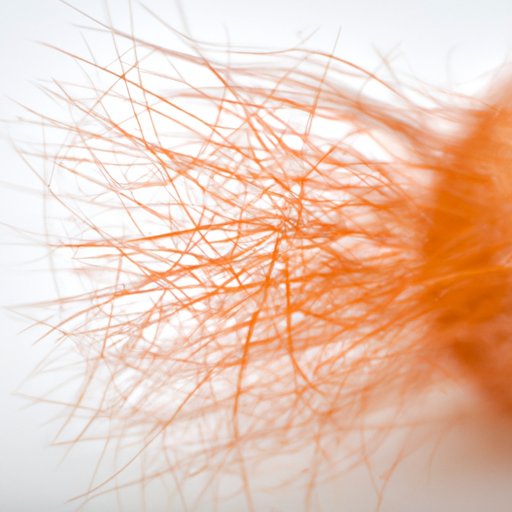
Introduction
Do you suffer from hair bumps? If so, you’re not alone. Hair bumps, also known as razor bumps or ingrown hairs, are a common skin problem that can be frustrating and sometimes painful. Hair bumps occur when hairs curl back into the skin or grow sideways, causing irritation and inflammation. This article will explore the causes of hair bumps and provide practical solutions to help you prevent and treat them.
Understanding the Causes of Hair Bumps and How to Prevent Them
The main causes of hair bumps are ingrown hairs, blockage of hair follicles, and skin irritation. Ingrown hairs occur when hair follicles become clogged with dead skin cells, forcing the hair to grow back into the skin. Blockage of hair follicles can happen when oils, dirt, or bacteria accumulate on the skin’s surface, leading to inflammation. Skin irritation can result from shaving too closely, using a blunt razor, or wearing tight clothing that causes friction.
To prevent hair bumps, it’s important to take proper precautions when shaving. Use a sharp razor and shaving cream to minimize irritation. Shave in the direction of hair growth, as shaving against the grain increases the risk of ingrown hairs. Avoid wearing tight clothing, especially when exercising or sweating. Tight clothing can rub against the skin, causing irritation and blockage of hair follicles.
Natural Remedies to Treat Hair Bumps
There are several natural home remedies that can help soothe hair bumps, including tea tree oil, aloe vera, and witch hazel. Tea tree oil has natural antibacterial properties that can help reduce redness and inflammation. Aloe vera has a cooling effect that can help soothe irritated skin. Witch hazel is a natural astringent that can help reduce inflammation and itching.
To use these remedies, apply a few drops of tea tree oil or aloe vera gel directly to the affected area. Gently massage the area to help promote absorption. For witch hazel, apply a small amount to a cotton ball and swipe it over the affected area. Repeat these remedies several times per day for best results.
Skincare Products Specifically Designed for Hair Bump Prevention and Treatment
Several skincare products are specifically designed to help prevent and treat hair bumps. Exfoliators, anti-bacterial washes, and moisturizing lotions are just a few examples. Exfoliators help remove dead skin cells, preventing them from clogging hair follicles. Anti-bacterial washes can help kill bacteria that cause inflammation, while moisturizing lotions can help soothe and hydrate irritated skin.
When selecting skincare products for hair bump prevention and treatment, look for those that include salicylic acid, glycolic acid, or benzoyl peroxide. These ingredients help unclog pores and reduce inflammation. Remember to patch test new products before using them on your entire body, especially if you have sensitive skin.
Exfoliation Techniques to Remove Dead Skin Cells and Prevent Hair Bumps
Regular exfoliation can help remove dead skin cells and prevent hair bumps. There are many ways to exfoliate your skin, including dry brushing and sugar scrubs. Dry brushing involves using a natural bristle brush to gently brush your skin in circular motions. Sugar scrubs involve mixing sugar with a carrier oil such as coconut oil and massaging it into your skin. Both of these methods can be used several times per week to help prevent hair bumps.
When selecting an exfoliation technique, choose one that’s appropriate for your skin type. If you have sensitive skin, opt for gentle exfoliation methods such as chemical exfoliants like alpha-hydroxy acids or lactic acid or a konjac sponge.

Tips for Shaving without Causing Hair Bumps
Proper shaving techniques can help prevent hair bumps. Ideally, you should shave after a shower or bath when the skin is warm and supple. Use a sharp razor to prevent irritation and shave in the direction of hair growth. Avoid shaving too closely, as this can increase the risk of ingrown hairs. Don’t shave over the same area more than once, as this can cause more irritation.
For different areas of the body, different shaving techniques may work better. For example, for the bikini area, avoid shaving too closely and don’t shave against the direction of hair growth. For the underarms, try using a men’s razor or a different type of blade with a smaller head.
Laser Hair Removal as a Long-term Solution to Hair Bumps
If you’re struggling to manage hair bumps, you might consider laser hair removal as a long-term solution. Laser hair removal methods work by targeting the hair follicles with heat or light, destroying them and preventing hair growth. This method can be expensive, but it could be worth it if you’re looking for a long-term solution to hair bumps.
When to See a Dermatologist for Severe Hair Bumps and Treatment Options
If you have severe hair bumps or they don’t respond to home remedies, it’s important to see a dermatologist. A dermatologist can diagnose the problem and offer treatment options, such as topical corticosteroids or antibiotics. They may also suggest hair removal techniques such as electrolysis or laser hair removal.
Conclusion
Hair bumps can be an uncomfortable and frustrating problem, but they’re not impossible to manage. By practicing good skincare and shaving techniques, using natural remedies, and incorporating hair bump prevention products into your routine, you can prevent and treat hair bumps effectively. Remember, if your hair bumps are severe or don’t respond to at-home remedies, don’t hesitate to see a dermatologist for help.




